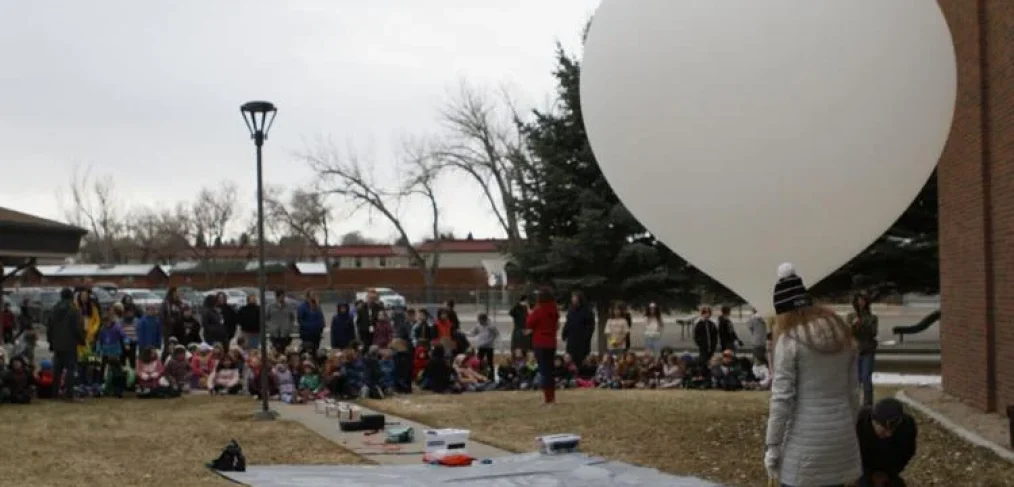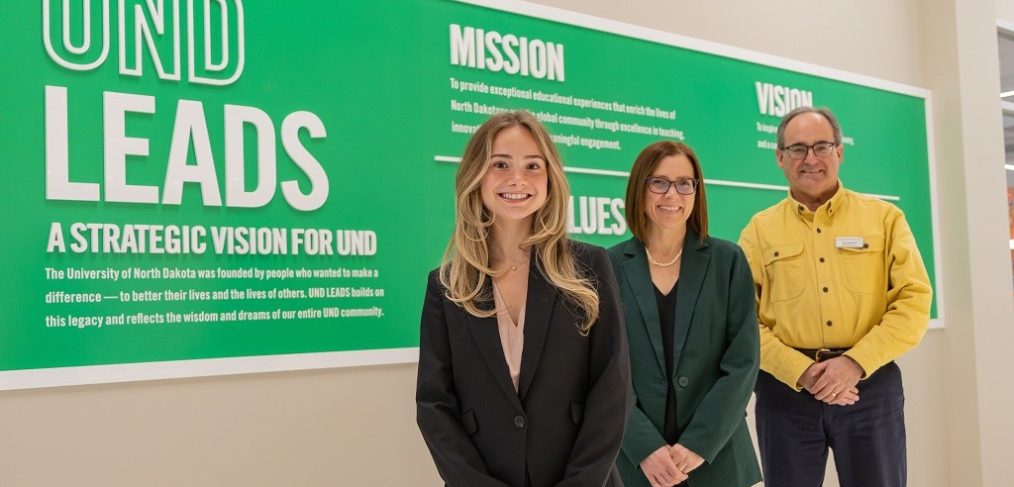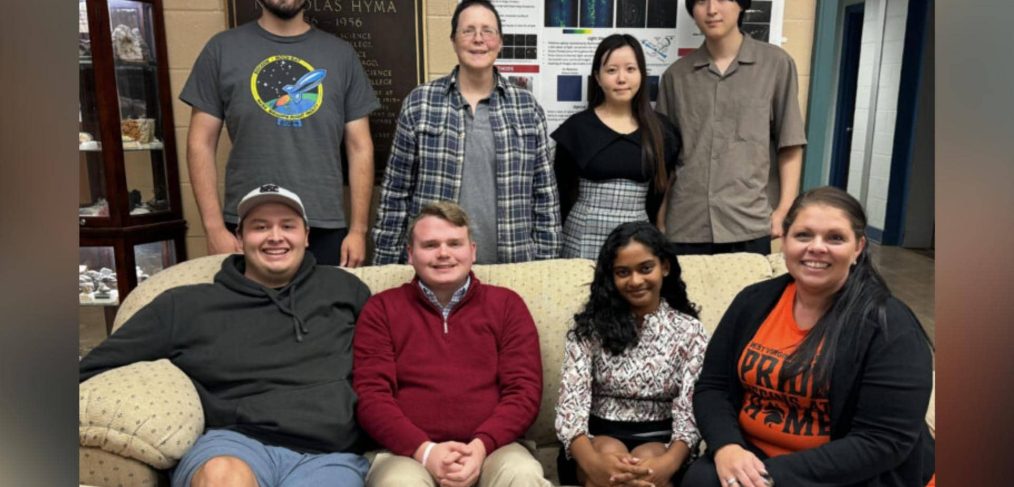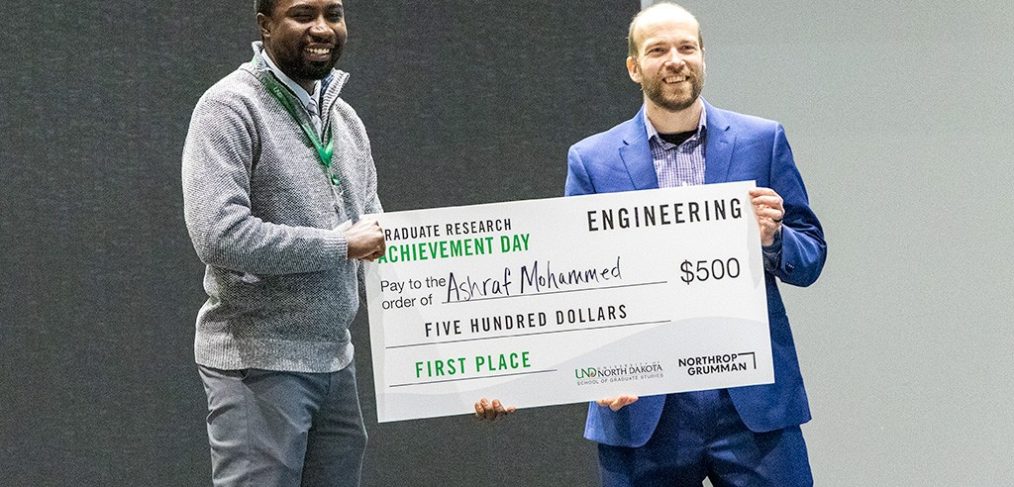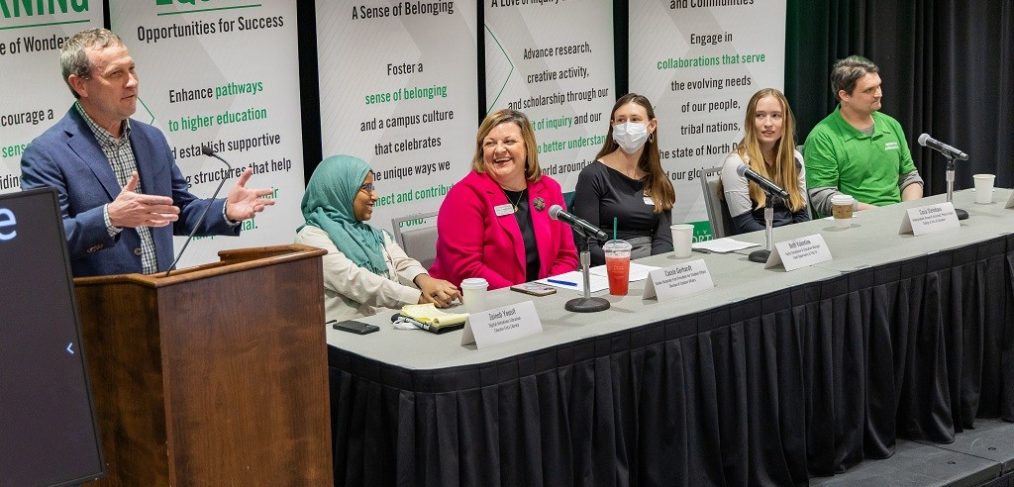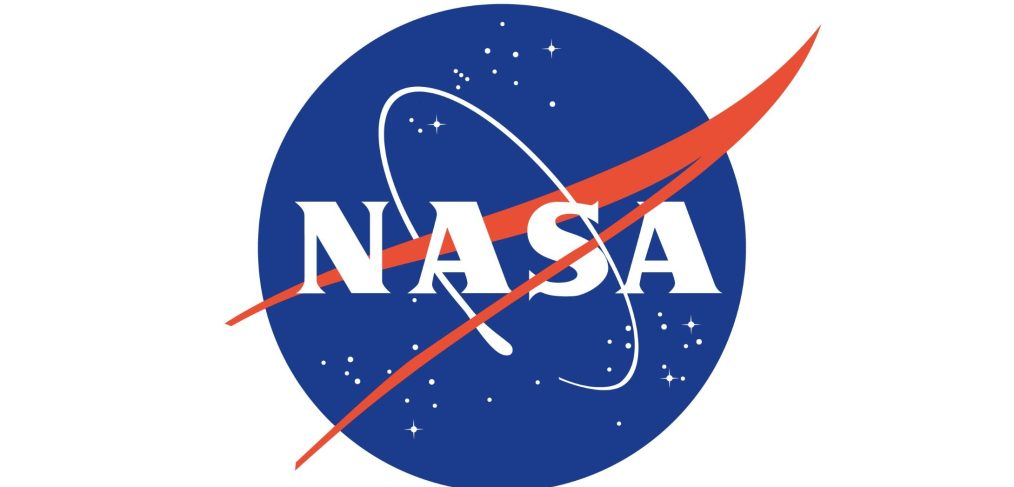University of Hartford Hosts NASA and Its Prime Contractors
More than 100 Connecticut manufacturers and processors converged on the University of Hartford to learn more about how to work with NASA and its prime contractors.
“Doing Business with NASA and Their Primes” was presented by CONNSTEP, Aerospace Component Manufacturers, Connecticut Office of Manufacturing, Connecticut Center for Advanced Technology, and the U.S. Commercial Service.
“We are incredibly excited to welcome NASA, their prime contractors, and CT industry partners to campus for this event,” said Hisham Alnajjar, the dean of UHart’s College of Engineering, Technology, and Architecture and interim director of the NASA CT Space Grant Consortium.
Alnajjar delivered the day’s opening remarks in Wilde Auditorium. He was joined by Connecticut Chief Manufacturing Officer Paul Lavoie, who served as event emcee.
“Since 1991, the University of Hartford has been proud to be the lead institution for the NASA Connecticut Space Grant Consortium, whose office is located on our campus,” said Alnajjar. “This fruitful partnership has led to hands-on learning opportunities that position our students and faculty to be leaders in the aerospace technologies of the future.”
Read the full article on NewsWise.com
Original Post Date: April 15, 2025
Author Credit: University of Hartford
Image Credit: University of Hartford
Students at Eastside Elementary attended a weather balloon launch performed by the Wyoming NASA Space Grant Consortium last Thursday morning.
The launch, which was coordinated by second grade teacher Julia Scott, occurred on the playground just south of Eastside. The event was originally scheduled for Wednesday, however poor weather conditions required that it be delayed by one day.
“When you’re planning something that needs pretty specific weather conditions and you’re in Wyoming, it’s a real roller coaster. There were high winds and snow Wednesday, so we decided to launch during a low wind pocket on Thursday, as that gave the balloon the best opportunity for an easy recovery,” Scott said.
Read the full article on Cody Enterprise.
Author Credit: Daniel Rasmussen
Image Credit: Daniel Rasmussen
Original Post Date: March 24, 2025
Chemistry assistant professor Yongick Kim receives funding from NASA WV Space Grant Consortium
Congratulations, Dr. Yongick Kim! Dr. Kim’s proposed project entitled “Circadian Clock-Controlled Nitrogen Fixation for Fertilizer Production in
Space” has been funded by NASA West Virginia Space Grant Consortium through their Research Initiation Grant program in the amount of $37,500 (NASA WVSGC: $25,000; Cost Share: $12,500).
Read the full story on Marshall.edu
Original Post Date: April 11, 2025
Author Credit: Marshall University
Helping young people ‘dream bigger,’ have ‘lasting impact’
Since joining the North Dakota Space Grant Consortium’s STEM Ambassador program in the fall of 2023, one of us (Amanda Curatti) has had the privilege of directly contributing to the community by providing meaningful service through STEM outreach.
Curatti’s role has allowed her to engage with young learners across North Dakota, creating a “front door to campus” and bringing STEM education directly to the communities that need it most.
By leading after-school programs and hands-on workshops, she has been able to work with children who often lack the resources or exposure to explore STEM fields. This work, which sparks curiosity and empowers future generations, truly embodies the spirit of service.
A core aspect of this mission has been to inspire underrepresented groups, particularly young girls, to pursue careers in fields such as aviation and space exploration. As a female in a traditionally male-dominated industry, Curatti strives to serve as a visible role model for students who may not otherwise see themselves in these careers. Last year, for example, she led the Grand Forks Mentor Center after-school program, which introduced exciting STEM concepts such as aeronautic demonstrations and space exploration.
This year, the Space Grant Consortium has expanded its efforts to work with Encore after-school programs, reaching more children across the state with activities such as “Rockets to the Rescue” and “UV Astronauts.”
One of the most rewarding aspects of her role, Curatti says, is witnessing the tangible impact of our outreach on students and the broader community. At events such as Girls in Aviation Day, she has seen young girls not only learn about coding and aviation, but also experience firsthand the possibilities that lie ahead for them.
Opportunities offered by the Consortium, such as internships at NASA, further deepen this impact, by giving students the chance to collaborate with some of the brightest minds in the world and contribute to projects shaping the future of science and technology.
Curatti’s service as a STEM Ambassador goes beyond education, in other words. It’s about creating pathways for students, especially in North Dakota, to dream bigger and pursue careers that will have a lasting impact on our state, our nation and the world.
And that’s what UND’s Service commitment is all about.
Read the full article on UND Today.
Author Credit: By Amanda Curatti, Tom Dennis and Daphne Pedersen
Image Credit: UND Today
Original Post Date: Feb. 25, 2025
The community is invited to blast off with the West Virginia Wesleyan College Space Club for science-themed fun and a chance to win prizes on Sunday, March 30 from 1 to 3:30 p.m.
Activities will be held in the auxiliary gymnasium located in Rockefeller Center. The first 50 kids will receive a NASA-themed drawstring backpack. The activities and science demonstrations will include a Tesla coil, bottle rockets, a paper airplane contest, a spaghetti tower contest and a popsicle stick catapult contest.
There are over $500 in prizes to be awarded in two age classes, over 10 years old and 10 and under. There will be a special chemistry presentation by Dr. Ed Wovchko who has promised a fun explosion experiment. There will also be tours of Wesleyan’s Science Labs for high school juniors and seniors. The door prize is a LEGO model of the Mars rover Perseverance. This event is sponsored by the NASA-WV Space Grant Consortium.
Read the full article on MyBuckhannon.com
Author Credit: https://www.mybuckhannon.com/
Image Credit: https://www.mybuckhannon.com/ | WVSGC
Original Post Date: March 21, 2025
Last summer, students in the College of Science, College of Agriculture, Biotechnology and Natural Resources and College of Engineering began working on research projects funded by the Nevada NASA Space Grant Consortium. The grant recipients, including eight graduate students and three undergraduate students, are studying a range of problems in astrophysics and the atmospheric sciences.
“The Nevada NASA Space Grant gives our students an incredible opportunity to tackle cutting-edge research and make real contributions to their fields,” Thomas White, Clemons-Magee Endowed Professor in Physics and advisor to two grant recipients, said. “It’s not just about the science—it’s about building careers, gaining hands-on experience, and working alongside mentors and NASA scientists in a collaborative research community. The projects supported by this grant explore big questions in astrophysics, planetary science, and advanced materials, pushing the boundaries of what we know. We’re truly grateful for this support in helping train the next generation of scientists and engineers.”
Many of the students presented their work at the Nevada NASA Space Grant Consortium Annual Statewide Meeting, participating in poster sessions, presenting, and networking with students and faculty from across the state whose work all advances the scientific missions of NASA.
Read the full article on unr.edu
Author Credit: Michelle Werdann
Image Credit: Nevada Today | NVSGC
Original Post Date: March 14, 2025
Energy, microlearning and radon, oh my!
At the recent Graduate Research Achievement Day (GRAD) event on Feb. 27. students from various disciplines presented their work, pointing to posters that showed how their studies could influence areas such as energy sustainability, workplace learning and radon testing.
During his introduction to the award ceremony, Scott Snyder, vice president for Research and Economic Development, described the core of what makes events such as GRAD Day — which is hosted by the School of Graduate Studies and Division of Research & Economic Development — so special.
“All of you, regardless of the discipline that you are in, are active in discovering,” he said. “You are pushing forward the boundaries of knowledge through all of the work that you do, and you should be incredibly proud of yourselves.”
More than 200 students, faculty and attendees filled the Memorial Union ballroom to discuss the research Snyder referred to, giving a glimpse of some of the impressive research happening at UND.
Jason Hicks (one of the award presenters), systems engineering manager at Northrop Grumman, is an alumnus of the North Dakota Space Grant Consortium.
Read the full story on UND Today.
Author Credit: Walter Criswell
Image Credit: Walter Criswell/UND Today.
Original Post Date: 3/6/2025
NDSGC STEM Ambassador, Casia Steinhaus, was invited to serve on a recent panel at the University of North Dakota, sharing her experiences and perspectives.
When a UND student posts his or her research results on the Chester Fritz Library’s Scholarly Commons, for all to see … or takes multiple, real-world internships to test-drive different careers … or even asks the Angel Fund to pay for a plane ticket home, where Mom’s illness has left siblings needing help …
Then it’s all going according to plan.
The UND LEADS Strategic Plan, that is.
As UND President Andy Armacost wrote in the introduction to the UND LEADS Strategic Plan in 2022, every college and division at UND should see the plan “as a way to form detailed initiatives aligning with the aspirational vision for UND, helping to move the institution forward.”
In the Memorial Union on Feb. 25, five campus leaders explained how their own work is helping to do just that. At the event, titled “Celebrating UND LEADS: An Update on the Strategic Plan,” the five took part in a panel discussion at the Memorial Union’s Social Stairs.
In a discussion moderated by Ryan Zerr, professor of Mathematics and associate vice president for Strategy & Implementation at UND, the panelists took turns explaining how their work fits in with UND LEADS and helps carry out the plan’s broad vision for the University.
Contributing to the success of UND LEADS
“We have accomplished much that has advanced UND LEADS,” Zerr said when he introduced the panelists.
“And we’re here today to talk with five individuals whose work exemplifies the way in which people are bringing the Strategic Plan to life. Our panelists will share their insights as well as the challenges and opportunities they’ve encountered as they contributed to the plan’s success.”
The panelists were Zeineb Yousif, digital initiatives librarian at the Chester Fritz Library; Cassie Gerhardt, senior associate vice president for Student Affairs; Beth Valentine, equity, compliance and education manager, Office of Equal Opportunity and Title IX; Casia Steinhaus, Physics and Mathematics major and undergraduate research assistant; and Nathaniel Johnson, assistant professor of Nutrition and Dietetics.
Read the full story on UND Today.
Author Credit: Tom Dennis
Image Credit: Tom Dennis/UND Today.
Original Post Date: 3/6/2025
Anabel Scarlet Xiaoyu Byars, a senior at the University of Alabama at Birmingham from Vestavia Hills, is one of seven UAB undergraduate students who was awarded a NASA Alabama Space Grant Consortium scholarship this year.
Designated as NASA Space Grant Scholars, each of the students demonstrated a proficiency in research and an aptitude for space-related careers. They have been awarded scholarships ranging from $750 to $1,500, and each student will conduct an outreach activity to educate and inform the surrounding community about science and technology.
Byars is a member of the UAB Honors College and is in an accelerated program that allows her to take courses that simultaneously count toward her bachelor’s degree and master’s degree. She is completing her bachelor’s degree in neuroscience and earning a master’s degree in biology.
Read the full article on vestaviavoice.com
Original Post Date: 12.2.25
Author Credit: vestaviavoice
Image Credit: NASA




